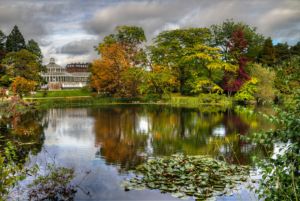Things to do
Museums Corner: After winter, spring should be a walk in the park
This article is more than 7 years old.

Østre Anlæg is just around the corner from Østerport Station (photo: Kenneth Sørensen)
Flowers, birds and budding trees – finally, spring has arrived!
This is the season of utter rejuvenation, in which nature is allowed to come back to life with full vigour and sheer beauty.
What better way to celebrate this magical time of year than going for a stroll in one of the enchanting Copenhagen gardens – while even getting a bit of culture as you go?
Promenade like a king
Kongens Have, Øster Voldgade 4A, Cph K
The King’s Garden (Kongens Have) in central Copenhagen is the oldest park in the city and has existed for more than 400 years. Once a private garden for the Royal Family alone, it is today one of the most popular hangout spots for the people of Copenhagen – you might even have to fight for space on the lawn on a sunny summer’s day. The park also serves as a setting for the traditional puppet theatre every day (except Mondays) during the summer from June 3 to August 20. Overlooking the garden is the captivating David Collection, regarded as one of the ten best Islamic art collections in the Western World. Additionally, the David Collection exhibits a selection of Danish early modern art and furniture.
The art of nature
Østre Anlæg, near Østerport Station, Cph Ø
The romantic Østre Anlæg was created to mimic wild nature with its curvy pathways and mountainous terrain. The park contains a variety of wild flora and fauna – especially in the lake. It also holds one of the best playgrounds in town. However, if the Danish spring weather is as unpredictable as ever, you can still enjoy the dazzling light and colours of nature through the Danish Golden Age and the Skagen painters’ art inside the Hirschsprung Collection situated in connection to the park. In the other corner of the garden you’ll find the National Gallery of Denmark (Statens Museum for Kunst). Here the permanent collection counts masterpieces by artists such as Monet, Gauguin and Degas. Their short, broken brushstrokes, which barely convey form and pure unblended colors, remind us of the bright briefness of summer.
Stop and smell the roses
Botanisk Have, Øster Farimagsgade 2C, Cph K
The Botanical Garden is located in the centre of Copenhagen and holds Denmark’s largest collection of living plants. The park is especially noted for its historical glasshouses dating from 1874, of which the Palm House is the most spectacular – drawing inspiration from London’s famous Crystal Palace. The Botanical Garden is part of the Natural History Museum of Denmark, which is situated a short walk away. Here you can experience botanical, geological and zoological objects collected over 400 years from expeditions to every corner of the world.
Playgrounds and monuments
Ørstedparken, Nørre Voldgade 1, Cph K
Along the old fortifications that protected the city up until the 1850s, the public park Ørstedparken, which is named after the Danish physicist Hans Christian Ørsted and his brother, was laid out in 1876. This stunning old park contains two popular playgrounds, a lake, barbecue areas and a unique selection of statues derived from Greek and Roman mythology. At night time, Ørstedparken is infamous for being a meeting point for gay people seeking a bit of romance. Right behind the park you’ll find the charming Nansensgade with quirky cafes, wine bars and antique book shops galore. Also in the neighbourhood in Nørregade is the cathedral Vor Frue Kirke, where Crown Prince Frederik and Mary were married in 2004. The cathedral is open to the public.
For more inspiration from the museums, visit Copenhagen Museums & Attractions at cphmuseums.com










































